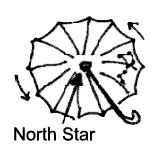BACKGROUND:
Stars are a fundamental component of galaxies. In the
lower grades students learned a simple classification of objects in the
Universe: those bodies in space that make light, and those that reflect
light. A star is an object that makes light, because much energy released
when hydrogen fuses, or "burns" to form helium.
There are many different types of stars. Stars are
classified by their color, which corresponds to their temperature. Blue
stars are extremely hot, 7,500E to over 25,000E Kelvin (273.16E Kelvin = 0E
centigrade). White stars are cooler (6,000E - 7,500EK), yellow stars range
from 5,000E to 6,000EK; orange stars range from is 3,500E to 5,000EK and red
stars are less than 3,500EK.
When we look at stars in the night sky, we do not see
them as they really appear, because they are at greatly varying distances
from Earth. From Earth we see each starís relative brightness. For
example, a dim nearby star might appear brighter and bigger than a faraway
very bright star. In contrast, if the stars were all the same distance from
Earth, we would see their absolute brightness. Bright stars would always
look brighter than dim stars.
Astronomers call a star's brightness its magnitude.
The brightness as we see it on Earth is termed apparent magnitude, while a
starís actual light output is called absolute magnitude. For instance our
Sun has an apparent magnitude of -26.8 (very bright) but an absolute of 4.8
(not bright). The derivation of these numbers is not important in the third
grade. The main point is that from Earth, we see only the apparent
brightness of the stars.
Astronomers group and name stars using their locations
and brightness. We usually think of grouping stars in constellations, but
these are artificial, historical associations which have little to do the
real magnitude and locations of stars. The main stars in each constellation
are labeled with a letter of the Greek alphabet, the brightest in the group
is usually termed alpha. The rest of the Greek alphabet is usually used to
label lesser brightness. Many stars are not even in constellations. These
are named with numbers.
|
LETTERS OF THE GREEK ALPHABET |
|

|
alpha |

|
iota |

|
rho |
|

|
beta |

|
kappa |

|
sigma |
|

|
gamma |

|
lambda |

|
tau |
|

|
delta |

|
mu |

|
upsilon |
|

|
epsilon |

|
nu |

|
phi |
|

|
zeta |

|
xi |

|
chi |
|

|
eta |

|
omicron |

|
psi |
|

|
theta |

|
pi |

|
omega |
In this lab, students will use the inflatable celestial
globes to find several constellations. This will help them develop a  sense of
star brightness and to learn how to locate stars in the sky. Many details on
the globe are too difficult for this grade. The following information,
however, is enough to allow the students to successfully use the globes.
sense of
star brightness and to learn how to locate stars in the sky. Many details on
the globe are too difficult for this grade. The following information,
however, is enough to allow the students to successfully use the globes.
The
area where you blow air into the globe is the location of the North Star,
commonly called Polaris. It was discovered early on that the night sky (only
in the northern hemisphere) seems to revolve around at fixed northern point;
the star closest to this location came to be called the North Star. Navigators
used the North Star to guide ships and caravans while traveling at night. The
height of the North Star above the horizon depends on the latitude at which
you live. The North Star is 40E above the horizon for most of the continental
United States.
If your students have trouble understanding that we
revolve around the North Star you can use an umbrella to illustrate this
point. Open the umbrella and draw two constellations on it with a piece of
chalk, or use glow-in-the dark stickers. Spin the umbrella. The spinning
represents movement of the constellations around a central point which
simulates the North Star.
The line labeled 0E on the globe is the celestial
equator. This is a projection into space of the Earthís equator. The months
of the year are written on the celestial equator. This indicates what
celestial objects are visible each month. The northern part is for the
northern hemisphere and the southern is for the people that live south of the
equator. Remember they see stars at a different angle than the United States.
For example, they do not see the North Star.
The 88 recognized constellations are enclosed within
dotted lines on the celestial sphere. These constellations help astronomers
create sectors, so they can locate other stars. Remember there are
constellations that can only be seen in the northern hemisphere and only in
the southern hemisphere.
PROCEDURE:
- Give students a celestial globe. Point out the location of the North
Star and the celestial equator (0E) to the
students. Explain the different symbols on the celestial globe by using
the information provided below.